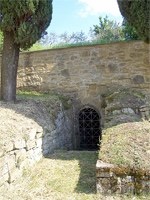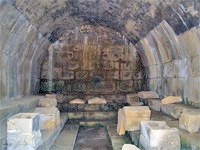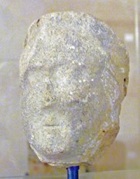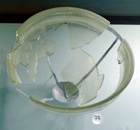



The tomb, which is built from local sandstone, has a small entrance in front of the barrel-vaulted main room. It was apparently modelled on the Ipogeo di San Manno outside Perugia. Some of the sarcophagi were made of travertine, probably in Perugia, while others in local sandstone. The tomb had already been robbed in ancient times, but funerary urns, glass vessels and gold and paste jewellery were discovered during the excavations of 1916. The study of the hypogeum itself suggests that it was built in the 3rd century BC, and the study of its contents suggests that it remained in use until the 1st century BC.
Four inscriptions are recorded in the report (1916) of the excavations:
-
✴Only one (subsequently lost) was complete: it recorded the Etruscan name, “curuna: verpru”.
-
✴The other three were in Latin:
-
•One (CIL XI 7982), which was initially recorded as “Perenna Flaminia or Flaminina”, has been lost, although it is known from a photograph. It was on the lid of a sarcophagus that had a sculpture of the deceased in a semi-recumbent position, and has been transcribed as “Perenna Flamini[..], son of Caius”. The style of the lid suggests that it dates to the late 2nd or early 1st century BC, and the name “Perenna is probably transitional, between the Etruscan “Perna” and the Latin “Perennius”.
-
•A second (CIL XI 7984), which was punched on a bronze sheet that had probably been attached to a sarcophagus, commemorated Voisius, son of Lucius. Only a fragment of the second line of the inscription survives: it has been transcribed as “Avania[...]”, and probably relates to the name of the mother of the deceased. This inscription, which is now in the Museo Archeologico, Perugia (see below), has been dated to the 2nd century BC.
-
•A third (CIL XI 7979, early 1st century AD), which was on a rectangular piece of “stone from Assisi” was recorded as:
SEX- VALERIVS SEX--
F- CLV- PROCVLVS
PR- ETRVRIAE
II- VIR
-
This third inscription (now in the deposit of the Museo Archeologico, Perugia) commemorates Sextus Valerius Proculus, son of Sextus, who had belonged to the the Clustumina Tribe and had been a duorviro and praetor Etruriae. Another inscription that seems to relate to this individual was found recently in Via della Sorgente (see Around Bettona).
Finds from the Ipogeo di Colle
The finds from the hypogeum were moved from Bettona to the Villa Giulia, Rome in the 1930s, except for:
-
✴the sarcophagi, which were returned to the hypogeum; and
-
✴a small travertine head of a woman (2nd or 1st century AD) from the lid of a sarcophagus that probably came from the hypogeum is now in the Museo Civico.

They were returned to Umbria in 1975, at which point some were lost. Those that survive, which are now in the Museo Archeologico, Perugia, include:
-
✴many pieces of gold jewelry;

-
✴a glass dish (2nd century BC) that was probably from the Middle East;

-
✴coins from the Republican era; and
-
✴a funerary inscription (late 2nd century BC) in archaic Latin punched on a bronze sheet, which commemorates

-
[-] UOISIUS L F [...]
-
AUIANIA[...]
-
[?] Voisius, son of Lucius and Aviania.
-
The name seems to retain the Etruscan formula, in which Avania’s name is apparently not preceded by the Latin “gnatus” (born of). The inscription is described in context in the page on Early Latin inscriptions.




